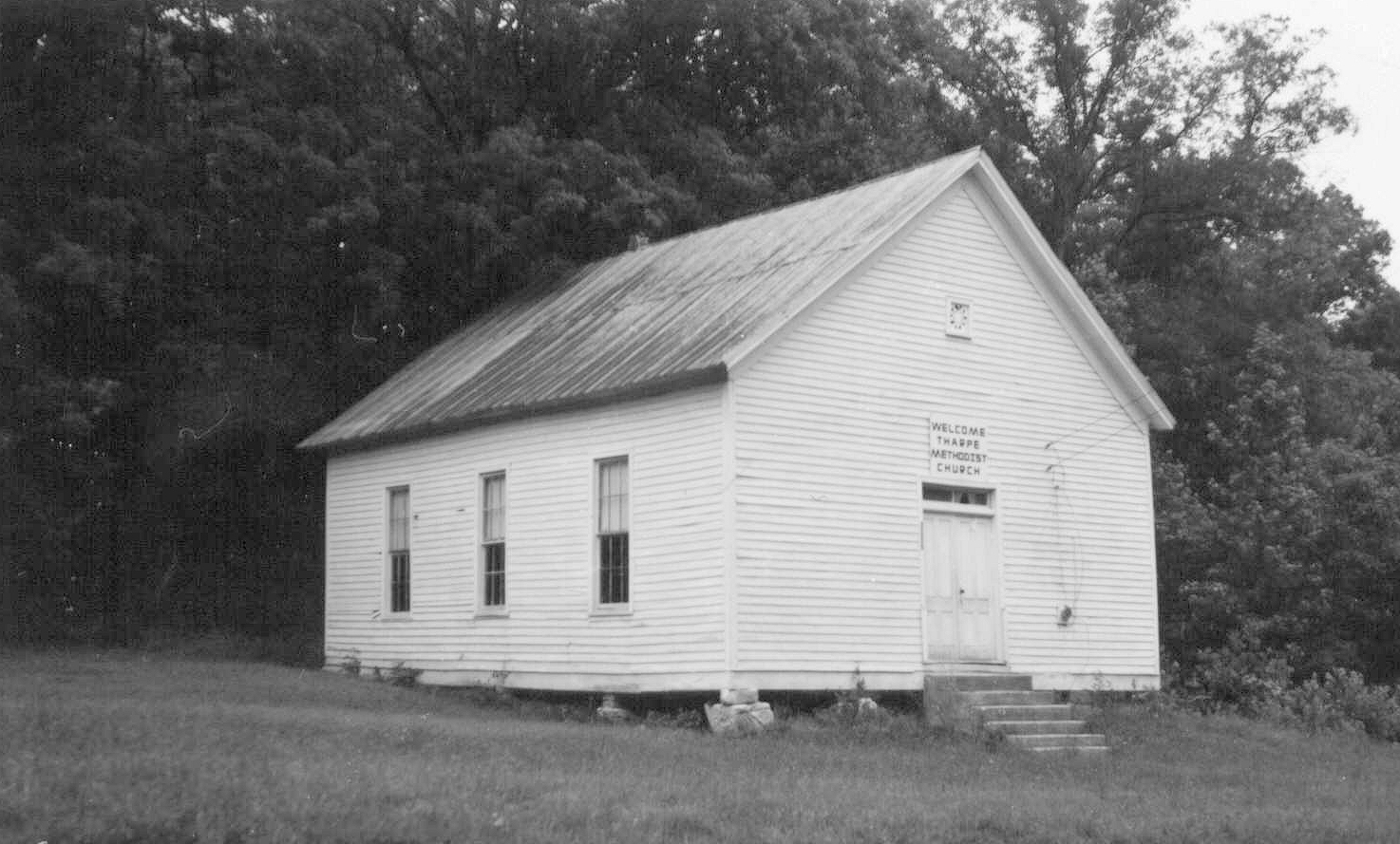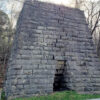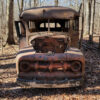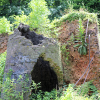Someone wrote an interesting slice-of-life account of the Tharpe community. The top of the document is titled Tharpe Churches and School. It may have come from the now-defunct BetweenTheRivers.org site. If anyone knows, please feel free to contact me and I will note proper authorship. It was likely written in the late 1960s.
Offering the nearest thing to social activities, the Tharpe Methodist Church was perhaps the most important structure to the people in the community.
Originally built at Old Bethel in 1877, the church was the meeting place for two social lodges, the Odd Fellows and the Rebbeccas. The lodges were the basis for much disagreement among members at various meetings. On one such occasion, Jack Skaggs said, “This church was built around the Devil and he is still under it.”
Even in the “out of the way” Bethel Community, the church drew capacity crowds on Sundays. One typical Sunday, the obviously illustrious preacher, Brother Hortin, looked out over the pulpit at the crowd and said, “Today I’m gonna open up Hell and let you smell the brimstone.”
At that time the church was located on what is now known as the Old Dunlap Place on the Iron Mountain and Ft. Henry Road near the Herndon Community. In 1901 the name and the location of the church was changed. Earnest L. Cathey directed the moving process. It was completely dismantled, loaded on wagons drawn by mules, and transported to the Tharpe Community where it was rebuilt–this time without facilities for lodges.
At this time there were no available stones for the foundation, so some of the men tore down an old chimney at the Dunlap place to use as foundation stones. These stones are still supporting the church.
Brimstone was not the main product at the church, however. Through the years the church was the site of many “all day singins and dinner on the ground.” These annual “get togethers” drew in the people who had moved away in past years. The one at the Tharpe church was each second Sunday in September.
On the “homecoming day” cars would fill the parking area and line the highway. Long strands of woven wire fencing was stretched between two trees in the rear of the church yard. Supported by poles and covered with cardboard, this improvised “table” was some 75-80 feet in length and was piled high with food of every description.
“It was a big job planning one of these events,” said Mr. O. K. Miles, a member of the church. According to Mr. Miles, the biggest job was getting a quartet. As he explained it, “If you did not book them far in advance, they would be scheduled to sing at some other event.” These homecomings usually featured three or four quartets.
Adjacent to the Methodist Church is the Church of Christ building. A brick structure, it was subcontracted by Rex Williams about 1960. It stands on the site where the Tharpe schoolhouse once stood. The proximity of the two structures made a religious influence on the educational process almost inevitable. During revivals, the services in the church started at 11 a.m. each day. The students were “marched like soldiers” from the nearby school to the church. There they sat quietly and listened to the sermon.
One teacher, Sam Morris, was a large, muscular man. During the sermons, he would sit behind the students watching their every move. If he saw any whispering or horseplay, (and as Mr. Miles put it, “He saw everything”) he would write down the students’ name. After the service, each of the wrong doers was assured of 15-20 licks with a three-foot-long hickory with a twist on the end.
The school, a place for baseball games, pranks, and punishment, often saw students reach their 20th or 21st birthday before they stopped going. “You would just keep going until you got tired of it or finally memorized the eighth grade. There was no higher school to go to around here,” said Mr. Miles.
One student, who “just got tired of going”, had a hard time escaping. Clarence Langster had been showing the usual restless signs that he was about to end his schooling. It was monthly exam time, and Clarence had decided to never take another test.
Mr. Morris, expecting an escape attempt, placed him in a position where he could easily glance at him while writing the test questions on the board. However, Morris was “too slow” in glancing one time. Langster made his attempt and was out the door in “three giant leaps.”
The teacher bounded after him “almost breaking the pine boards in the floor.” Although he chased him for several minutes, the exhausted teacher returned hot, tired, but without Clarence who never returned to the schoolhouse again.
Another Tharpe school teacher, Miss Neva Cherry, had a unique method of punishment. The pine floors of the school had four holes bored in them to let out the water after periodic scrubbings. The holes were a little larger than a man’s finger.
When a student was caught in the act of or suspected of doing wrong, he was required to place his “readers’ next to one of the holes and bend over and place his finger in the hole. Some students are alleged to have stood in this position for up to three days straight, during the sun-up to sun-down school days.
One student received an added touch to this common punishment. As he stood there bending over his textbook, his finger in the auger hole, one of his classmates had a “brilliant” idea. He left the room, supposedly to go “up the hill.” instead, he crawled under the floor to the spot where the finger was dangling through the hole. He grabbed the finger and held on to it while its owner screamed so loud “you could hear him for a mile.”
The school has long since been moved away, leaving as its only reminder the well that Tommy Lions “witched” many years ago. The building itself now stands two houses south of Crutchers Grocery and is the home of Guss Bowen.
The Methodist Church standing next to the site of the old school is closed now. Its last regular service was in 1964, and the last homecoming was in 1966. The wire table used in that event still stretches between two trees in back of the church.
Once the community was growing and the members were going to build a new church. Progress on the new structure stopped after the foundation was poured 16 years ago. The foundation, now barely visible under the growth of weeds, tells the story of the decreasing population over the past decade. Many of the members were moving to more urban communities and the ones who stayed were hearing rumors of a new park in the area, so the old building was given a new lease on life.






Pingback: Tharpe, Tennessee - Four Rivers Explorer